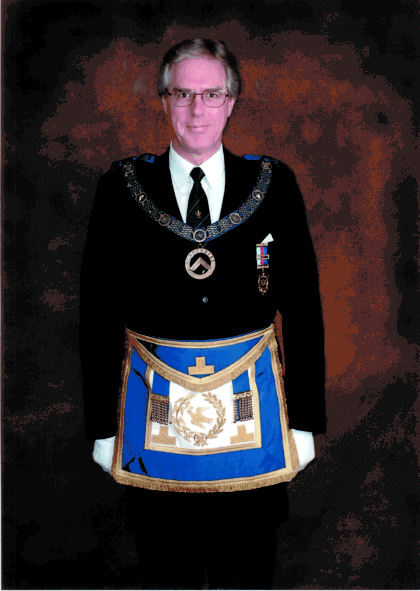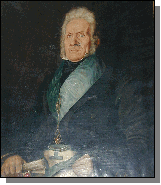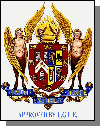 Freemasonry
as practised today is a world-wide Brotherhood based upon the tenets of
Brotherly Love, Relief and Truth (in modern parlance, Fellowship, Charity and
the pursuit of high ideals). While its ritual is derived from the Old Testament,
and particularly the history of the building of King Solomon's Temple,
Freemasonry is largely non-denominational and not - in its present form, at
least - much more than four centuries old. The secrecy which has surrounded its
ceremonies has also served to obscure its origins, despite the best efforts of many
Masonic historians to unravel them.
Freemasonry
as practised today is a world-wide Brotherhood based upon the tenets of
Brotherly Love, Relief and Truth (in modern parlance, Fellowship, Charity and
the pursuit of high ideals). While its ritual is derived from the Old Testament,
and particularly the history of the building of King Solomon's Temple,
Freemasonry is largely non-denominational and not - in its present form, at
least - much more than four centuries old. The secrecy which has surrounded its
ceremonies has also served to obscure its origins, despite the best efforts of many
Masonic historians to unravel them.
Many elements of Freemasonry derive from the practices of
medieval Guilds, notably, of course, the stonemasons. 'Freemason' is generally
taken to imply a Brother who, though probably not an operative stonemason, was
nevertheless 'accepted' into a Masonic Lodge. Symbolism, uniform and modes of
recognition all hark back to the days when it was important for genuine members
of the Guild to recognise as well as support one another as they moved from
place to place.
Each Lodge has its own Worshipful Master, and the Brethren
progress from Entered Apprentice through to Master Mason, each 'degree' having
its own ceremony and symbolism through which the candidate is instructed in
moral and social virtues. Religion and politics are by long tradition excluded
from Lodge discussions.
Modern Freemasonry probably began in Scotland; one John
Boswell (an 'Accepted Mason') is recorded as a member of an Edinburgh Lodge in
1600. Elias Ashmole, founder of Oxford's Ashmolean Museum, is the first known
English Mason, joining in 1646. Four London Lodges founded the first Grand Lodge
in 1717. Frederick, Prince of Wales was admitted in 1737. Many Royals and other famous men have
been distinguished Masons since then, including Alexander Fleming, the Duke of
Wellington, Rudyard Kipling (read "The Man who would be King"), the
submariner Tommy Gould, Franklin D. Roosevelt, Davy Crocket, Tom Thumb, Oliver
Hardy, John Wayne, Peter Sellers, Ernest Shackleton, J. Edgar Hoover, Jack
Dempsey, Wolfgang Amadeus Mozart, Louis Armstrong, Gilbert (and Sullivan!), and
Robert Burns.
 In 1813 the 'Antient' and 'Modern' Grand Lodges in London amalgamated
to form the United Grand Lodge of England. Two
Shropshire Lodges pre-date this foundation: Salopian Lodge number 262 (a
'Modern' Lodge) was formed in 1788 and Salopian Lodge of Charity number 117 (one
of the last 'Antient' Lodges) in 1810. Both still meet in Shrewsbury.
In 1813 the 'Antient' and 'Modern' Grand Lodges in London amalgamated
to form the United Grand Lodge of England. Two
Shropshire Lodges pre-date this foundation: Salopian Lodge number 262 (a
'Modern' Lodge) was formed in 1788 and Salopian Lodge of Charity number 117 (one
of the last 'Antient' Lodges) in 1810. Both still meet in Shrewsbury.
While
the 18th century had seen a huge rise in the popularity of Freemasonry, the 19th
saw it spread to every part of the globe. Masonry became particularly popular in
the United States (George Washington was a Mason) and survived in the most
unlikely places and situations. The 20th century has seen the veil of secrecy
drawn tight around the Craft, notably under persecution by the Nazis and under Communism, but in recent times this veil has been lifted. 'Openness' is the new
buzzword at the United Grand Lodge of England, which is keen to stress the good
work done for Masons and non-Masons alike by its more than 600,000 members
Freemasonry today is thus a world-wide Brotherhood, dedicated
to the maintenance of its traditions, its pursuit of a moral lifestyle - and to
the enjoyment of good company among like-minded Brethren.

 Freemasonry
as practised today is a world-wide Brotherhood based upon the tenets of
Brotherly Love, Relief and Truth (in modern parlance, Fellowship, Charity and
the pursuit of high ideals). While its ritual is derived from the Old Testament,
and particularly the history of the building of King Solomon's Temple,
Freemasonry is largely non-denominational and not - in its present form, at
least - much more than four centuries old. The secrecy which has surrounded its
ceremonies has also served to obscure its origins, despite the best efforts of many
Masonic historians to unravel them.
Freemasonry
as practised today is a world-wide Brotherhood based upon the tenets of
Brotherly Love, Relief and Truth (in modern parlance, Fellowship, Charity and
the pursuit of high ideals). While its ritual is derived from the Old Testament,
and particularly the history of the building of King Solomon's Temple,
Freemasonry is largely non-denominational and not - in its present form, at
least - much more than four centuries old. The secrecy which has surrounded its
ceremonies has also served to obscure its origins, despite the best efforts of many
Masonic historians to unravel them. In 1813 the 'Antient' and 'Modern' Grand Lodges in London amalgamated
to form the United Grand Lodge of England. Two
Shropshire Lodges pre-date this foundation: Salopian Lodge number 262 (a
'Modern' Lodge) was formed in 1788 and Salopian Lodge of Charity number 117 (one
of the last 'Antient' Lodges) in 1810. Both still meet in Shrewsbury.
In 1813 the 'Antient' and 'Modern' Grand Lodges in London amalgamated
to form the United Grand Lodge of England. Two
Shropshire Lodges pre-date this foundation: Salopian Lodge number 262 (a
'Modern' Lodge) was formed in 1788 and Salopian Lodge of Charity number 117 (one
of the last 'Antient' Lodges) in 1810. Both still meet in Shrewsbury.